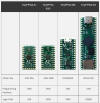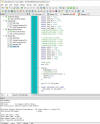- TinyFPGA is a ~$20 FPGA board (A
series is based on the
MachXO2
FPGA chip from Lattice)
-

- There are a few versions being advertised
now: A1, AX2, BX, and EX
- Looks like A1 was the first version, with
XO2-256 chip in QFN-32 form
- The AX2 (also called A2) is also
available now, based on XO2-1200, also in QFN-32 form
- The BX and EX are more powerful and include a
USB programmer. But, these don't look to be available until 2022
- Great thing about TinyFPGA is that everything is open source, including
board designs and programmer code
- You use Lattice Diamond to generate the JEDEC programming file (.jed)
- Lattice Diamond is NOT open source and
required you to apply for a free license
- To get the license, you need to run ipconfig
/all in DOS prompt to figure your internet adapter physical address
- License doesn't work over Remote Desktop :(
- Can be programmed using custom, ~$10,
programming board for A1 or AX2 or with the ~$200
Lattice programmer
- The TinyFPGA programmer works fine but does
require a Python program to program it whereas it looks like the Lattice
one works directly with Lattice Diamond
- There are some ~$25 knock off programmers on
Amazon.com that appear like they would also work
- The TinyFPGA programmer is based on the X and is open source design and
code
- For now, the AX2 looks the most interesting due to simplicity and low
cost
-

- Looks like a great place to start for someone
learning FPGA
- Getting Started with AX2 (probably applies
to A1 too)
- The official A-series
gettings started page
is very good (backed up
here)
- Note: You need to supply 3.3 V power
to the AX2 somehow.
- The guide shows how to use a 3.3 V regulator
to do this from a 5 V supply
- They really should have some capacitors on
either side of that regulator!
- First step is to install Diamond Lattice
(and get and install license file)
- Note: You must "run as administrator"
the setup program
- Next, follow
the guide to start a
new project from the
template on github,
or use my blink project files here
- Note: I've used a "~" to invert the
output signals, making the active low instead of active high
-

- In Diamond Lattice, double-click on "JEDEC File"
to get the green check mark showing it made the .jed file as shown below
- Next, open that .jed file with the Python 2.7
programming tool (installer copied
here)
-

- Note: Programmer has to be connected
and attached to powered AX2 board for program to work!
- Setting the system clock
- The blink example uses the lowest possible
clock setting of 2.08 MHz
- The clock is set by this code:

- This is using the internal 133 MHz oscillator
(only 5% accuracy), that is then divided down
- You can see above the commented out code to
switch to 133 MHz, you can change by uncommenting this and commenting
out the line above it
- Here is the table of frequencies usable this
way:
 (from the the MachXO2
sysCLOCK PLL Design and Usage Guide)
(from the the MachXO2
sysCLOCK PLL Design and Usage Guide)
- Using a Schematic (instead of Verilog .v file)
- The example above is in Verilog text
language, but would like to explore the graphical schematic
- Found a college
course lab that shows how to do this
- Made this
project from this that adds an AND gate to the blink project, and
comments out the counter output
-

- Using an external oscillator
- It appears you use an external oscillator to
generate a more precise clock (see
this note)
- Also, the AX2 version has a PLL that looks
like it could be used to increase or decrease that external oscillator's
frequency.
- Other interesting notes:
- Useful looking things on the web:
- Can we make our own loader hardware and/or
software
- Found an open source .svf loader on Github,
Lib(X)SVF. Diamond has a "Deployment Tool" that can turn the .jed
file into a .svf file
- Using an FT231x looks like a good option too.
Found some info on that at fleasystems and openfpgaloader
- Using Visual Studio Community, set up a
TinyFPGALoader Python project and started hacking that. Got it to
allow P2's FT231X chip to be an option, but decoding the serial output
is proving to be a challenge. All the info is there in Github to
make that happen though.







